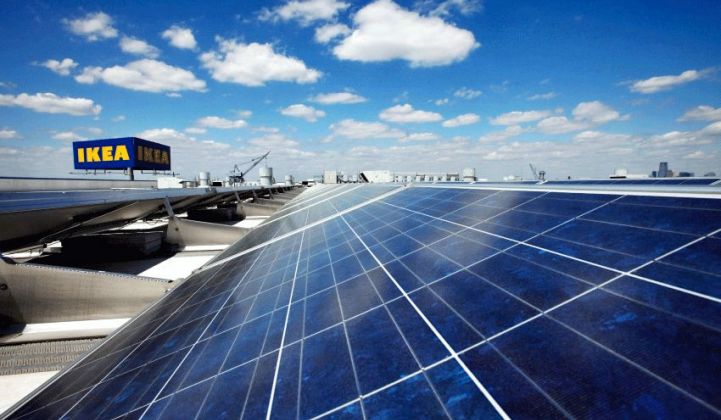The news from Paris this weekend was as good as anyone hoped: world leaders signed an accord that seeks to limit global temperature rise below 1.5 degrees.
This is historic and represents a huge step for the multilateral process. But make no mistake: this is just the start of the heavy lifting.
The first major task will be ratification by individual countries. The agreement won't come into effect until 55 countries representing at least 55 percent of global emissions ratify it. Since there are no legally binding carbon targets, the deal doesn't have to go through the U.S. Senate -- one of the major issues that killed momentum on the Kyoto Protocol.
The carbon reduction targets will be voluntarily determined and set by individual countries. These "nationally determined contributions" will start in 2020 and will be reviewed every five years. For reference, the voluntary targets proposed in Paris put us on a path of 2.7 degrees of warming.
Some estimate that we're close to locking ourselves into 2-degree future -- meaning we need to quickly ratchet up the targets. Many are worried about the non-legally-binding nature of the targets themselves. Yet, it's a framework and a start.
The fact that 195 countries have agreed to lower carbon emissions is a big deal. And that means more investment certainty for the solar industry.
America's goal is to cut carbon emissions 26 percent to 28 percent below 2005 levels by 2025. Solar will definitely play a role in this this, most prominently through the Clean Power Plan, which was foundational to the submitted carbon reduction targets.
Solar and other renewables have been a key piece of broader policy efforts by the Obama administration. Over the past six months, the White House has thrown its support behind community solar, solar for low-income households, and training programs. Through initiatives like DOE's SunShot, it continues to invest in companies working to bring down the cost of manufacturing, installation and sales.
The Obama administration has also worked with a consortium of over 150 corporations targeting emissions cuts, water-usage reduction, and renewable energy procurement. The initial 13 members, including Apple, Google, Wal-Mart and Goldman Sachs, were targeting 1.6 gigawatts of new renewable procurement alone. Much of that procurement is coming from solar.
The big question on the federal level will be whether Congress can extend the Investment Tax Credit. The politics around the ITC are mostly divorced from the international climate talks, so the Paris deal likely won't have much influence on the current horse-trading or different pathways for extension in the short term.
Globally, the result is equally unclear -- but certainly positive.
Just like the U.S., most countries are vague about how they'll achieve planned reductions. Only one country specifically calls out solar PV (Nauru, with a population of 10,000) in the summary statement of its plan. Many more call for adoption and investigation of renewables generally -- the most significant being China and India's 2030 targets for "non-fossil" electricity generation at 20 percent and 40 percent, respectively.
Similarly, Brazil hopes to get 23 percent of its electricity from non-hydro renewables by 2030. In addition, the EU will certainly count on its Renewable Energy Directive -- the region-wide renewable energy targets of 20 percent by 2020 -- to meet its targeted reductions.
In that sense, we will likely see additional country renewable portfolio targets emerge, providing incentives or other support mechanisms for renewables like solar.
The developed countries have the biggest reduction targets (they're the biggest historical emitters), so that's where most of the resulting solar development is likely to occur. However, emerging economies (Brazil, China, India and South Africa) have huge potential for policies that encourage rapid expansion as their energy footprint grows. As mentioned, India, China and Brazil all have big 2030 targets for renewable penetration.
In addition, the non-binding preamble of the Paris deal calls for $100 billion of financing commitments to help developing countries most affected by climate change. Climate finance has been a huge sticking point ever since it was proposed at Copenhagen and formalized in Cancun, sparking intense debates over how much rich countries should spend, when the money should be delivered, how it's administered, and which projects should qualify.
This climate fund is a potential avenue for financing clean energy in nontraditional renewables markets. However, the funding hasn't been there -- only $10 billion has been pledged thus far, and half of that hasn't actually been signed over.
Nevertheless, with the Paris convention looming, the Green Climate Fund awarded its first projects in early November. One award went to an Acumen venture fund for off-grid solar and microgrids in eastern Africa, and another for the Inter-American Development Bank to finance energy efficiency in Latin America. It still remains unclear whether these investments will scale to support large-scale renewable projects.
Outside of the negotiations, there were some non-binding initiatives being pushed, too. Paris provided a launching platform for Dubai's plan to build solar on all roofs by 2020, the Breakthrough Energy Coalition pushed by Bill Gates and Mark Zuckerberg, a parallel investment initiative by 19 countries, and an ambitious $400 million global solar alliance founded by India.
Cumulative solar installations are nearly 12 times greater globally than they were during the Copenhagen climate conference in 2009. Solar was bound to explode with or without a deal in Paris -- but the new framework will undoubtedly widen the available markets for the technology.



